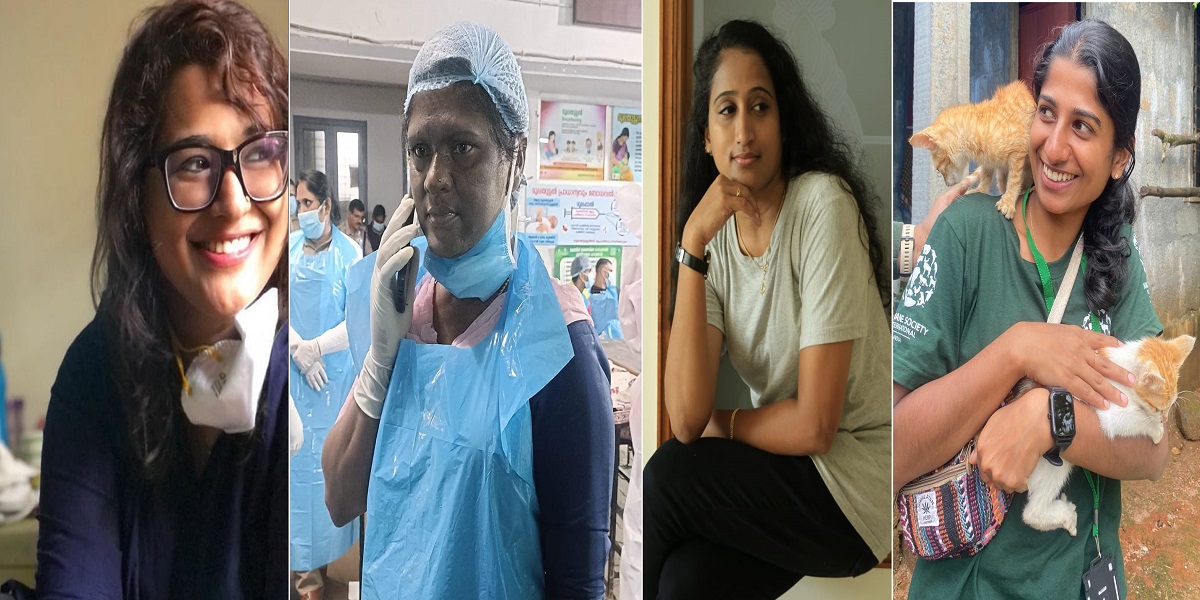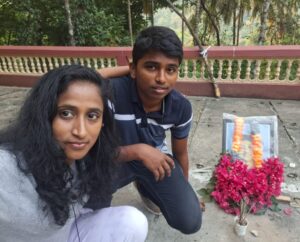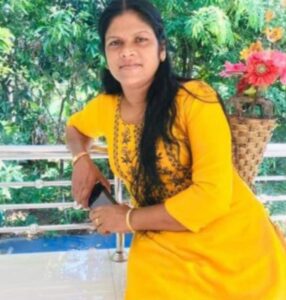Many women are in the forefront at the landslides-ravaged areas in Wayanad. A majority of them work tirelessly, far from the media glare.
Published Aug 08, 2024 | 11:00 AM ⚊ Updated Aug 08, 2024 | 12:37 PM

Women like (from left to right) Dr.Lovena, Shyja, Deepa, and Nayana, along with numerous others, have been working tirelessly in rescue missions.
Clad in army fatigues, and her hair tied tight into a bun, she stood on the panel of the under-construction Bailey Bridge connecting the landslides-ravaged areas of Mundakkai and Chooralmala in Wayanad.
Darkness has descended on the area, as a ‘Thambi’ — as Madras Sappers are referred to — stood behind her. Unlike her, he had a raincoat over his uniform.
The woman — Kerala later came to know her name, Major Sita Ashok Shelke — looked determined and focused. The Iruvanchipuzha below was still in spate, its muddy rapids threatening to take away anything that stood in its way.
Hours ago, the river had washed away a British-era bridge. Search and rescue operators who arrived at the scene could not withstand the fury of Iruvanchipuzha and cross over to the area where hundreds remained buried under tonnes of earth, boulders, and debris that the landslides had brought thundering down the heights of the Western Ghats.
Gloom shrouded the area as the night that came through the thick fog hid the landslide-hit area. In daylight, the area looked like flesh in an open gash on Earth’s chest.

Major Sita Ashok Shelke overseeing the construction of the Bailey Bridge.
The grim scenes — including the silence of the bereaved, numb and tearless — would have affected anyone, weakening them. Yet Major Shelke stood on the panel, taking stock of the bridge’s progress and instructing the “boys” — as she calls them. She stood tall, shattering gender stereotypes.
The media — overwhelmed by the Army’s professionalism — took note of her. Major Shelke’s picture flooded social media, with users going gaga over her.
Later as she walked across the now-opened bridge, the media caught up with her. A little pause while she recalled with gratitude the help local residents had extended to the Army was the only apparent sign of emotion she exhibited.
Her voice was firm. Her head remained high. Reporters were keen to know her experience as the only Army woman in the field.
“There is nothing called women in the Army. I am a soldier on the ground. I am just doing the task assigned to me. I am working as part of the Indian Army. That’s it,” Major Shelke continued walking.
The Army officer, a graduate in Mechanical Engineering, was one among several women who rendered selfless service in the disaster area. Most remain behind the scenes, far from the media glare.
The mountains reverberated with the hurried wails of ambulances that kept arriving and leaving the disaster scene. The drivers had forgotten fatigue and hunger, as they maneuvered the winding roads that were further narrowed by parked vehicles.
Behind the wheels of one such ambulance, Deepa Joseph downshifted the gear and stepped on the pedal for an extra thrust. The vehicle wailed through the darkness, the emergency lights momentarily lighting up the shrubs and trees along the road. Her muscles which ached till a few hours ago, have now adapted to the sudden shift in activity.

Deepa and her son near Angel’s grave.
Practice makes a man perfect, goes the dictum. In emergencies, practice unleashes muscle memory. She drove the vehicle with ease.
Joseph was undergoing treatment for a muscle disorder at Kallachi Ayurveda Hospital when Vadakara Motor Vehicle Inspector EK Ajeesh contacted her over the phone. He wanted to know if she could reach Meppadi with an ambulance with a freezer facility.
Realising the urgency of the situation, Joseph got down to work. She did not have a freezer. A few phone calls later, she managed to get one from Niravummel Yuvadhara Club, with the help of Anas, an ambulance driver from Parakkadav.
“I reached Wayanad on Tuesday, 30 July, night. I have now returned home to see my son, and I will be heading back to Wayanad this evening,” she told South First.
“During these days, memories of my Angel seldom crossed my mind,” the mother said.
The Angel she referred to was Angel Maria, her daughter. On 26 September 2023, Maria hugged her mother one last time, whispering “I love you.” Death that slithered in the form of a snake had claimed the 17 year old a year ago.
The mother and daughter used to begin their days with an “I love you” greeting.
Wayanad presented her with an unforgettable experience she wanted to forget. The personal protective equipment she wore made eating impossible, and challenged the muscles of her urinary bladder. She mostly thrived on one meal, which she had at around 2 hours past midnight.
She slept in the ambulance itself, and a lack of medication made her vomit by day five. The retching sensation remained a constant with her.
Joseph recalled that they had to handle bodies with utmost care. “We cannot put pressure since our fingers would sink into the flesh. I saw the eyes of a girl’s decomposing body. They have swollen to the size of my palm,” she said.
She had been through deaths earlier, but they were of no comparison with what she witnessed in Wayanad. There were the dead, and there were the walking dead.
“I came across a man who said he was not even searching for his dead daughter in the morgue. He had no money to buy a coffin,” she said.
The landslides of 30 July wiped away everything in its way from the earth’s face.
The dead felt nothing, even when search volunteers’ fingers sank into their flesh. They were gone. Those left to live walked like expressionless zombies, aimless. A strange numbness has frozen their feelings.
Joseph had received accolades for her work during the Covid-19 pandemic, and trophies at her house at Nadapuram in Kozhikode stand testimony to her selfless service. She drives an ambulance belonging to a trust. She dreams of a stable job and a steady income.
Even as Joseph occasionally saw the darker-than-night silhouettes of the still, imposing mountains through sheets of rain while steering the ambulance to Wayanad, Dr Lovena Muhammed, too, was nearing Meppadi.
Dr Lovena Muhammed is acrophobic. When the situation demanded, she conquered fear.

Dr Lovena Muhammed crossing the river.
An Emergency Medicine Senior Specialist at Aster MIMS Hospital in Kozhikode, Dr Muhammed was in Mysuru when she received a call from her mother Dr Sabira Banu.
“My mother is a socially committed person and manages a shelter home in Kozhikode. She’s the one who encouraged me to become a doctor and steered me towards emergency medicine. She believes that we should give back something to society,” the young doctor recalled.
Dr Banu had called her daughter to cancel the Mysuru trip and proceed to Wayanad.
At Ground Zero, there was no dearth of challenges. They kept flooding in. The Iruvanchipuzha has washed away the only bridge, dividing Chooralmala. Several people stranded on the opposite bank needed medical help.
The urgency of the situation demanded a medical professional to cross the river. It was decided to employ the Tyrolean traverse method to reach the needy.
Dr Muhammed remembered calling her mother before crossing the river through a suspended rope.
“She asked me not to be scared, saying that even if I died, she would be happy to consider me a martyr (laughs). Despite my fear of heights, I decided to go,” she said.
She provided first-aid to the injured after reaching them. There were cases of spinal cord injuries. She also helped in airlifting the injured.
However, one instance will remain in her memory forever. She had to evacuate a three-month-old baby. The medicine kit Dr Muhammed carried with her turned into a cradle and took the infant to safety.
And what about Dr Banu? She saw TV visuals of her daughter dangling from a rope and crossing the thunderous river. “She is very proud of me,” Dr Muhammed, who now carries the burden of a lifetime experience, said.
The bodies kept coming — so did body parts. Most bodies looked alike, covered in mud, a poignant reminder of what nature’s fury could do.

Shyja Baby, ASHA worker.
An ASHA worker from Mundakkai, Shyja Baby, identified around 100. The body parts, however, offered little help in identifying the deceased.
A former ward member of the Mundakkai panchayat, Baby has stationed herself at the Meppadi Health Centre. Someone has to receive and identify the bodies, many of them ‘orphaned’ after entire families were killed in the savage landslides.
The social worker found little time to mourn the loss of her nine family members. For her, the people in Mundakkai and Chooralmala were part of her extended family.
She had survived two back-to-back landslides earlier: One at Kavalappara that killed at least 60 and another a day earlier at Puthumala, both in August 2019. Neither had prepared her for a catastrophe of the magnitude of the landslides of July 2024. She had relocated to Meppadi after the 2019 landslides.
“I became a widow at the age of 25 when my husband took his own life due to debt. My children were only 4 and 2 years old, respectively, at the time. I started working with Childline and later became an ASHA worker with the health department,” she told South First.
Becoming a single mother of two at a young age was not easy. “But the people of Meppadi become my extended family. This village helped me rebuild my life and supported me through the toughest times,” Baby further said.
More than a week has passed since the tragedy. “I will continue my service until the last body is recovered, as they were once my pillars of strength,” she added.
Nayana Scaria will never forget a pair of glistening eyes that kept looking at her.

Nayana Scaria.
The State Coordinator of Humane Society International India (HSI-India), Scaria, along with her team, has been tending to animals orphaned by the landslides.
They were injured, famished, fatigued, and scared. They looked up at each passerby, hoping to get a glimpse of a dear face or a whiff of the scent of those who had been their own.
Despite the hardship, they never complained, but silently moved among the strange crowd of people with outlandish equipment occupying their now-changed-beyond-recognition territory.
Some found the location where their house had been, perhaps hoping that their dear ones would emerge from the depths of debris. None came.
A few were lucky as their owners lived to come in search of them. Each such meeting brought the activities to a standstill, as the four-legged companions wailed and mooed in ecstasy amid the thick gloom hanging low over the area.
HSI-India has opened a 24/7 animal rescue control room to take care of the orphaned animals. “We have provided relief to 20 dogs, seven cats, and 22 heads of cattle,” Scaria told South First.
Her team searches the affected areas and gets tip-offs from relief camp residents, as well as the NDRF, SDRF, Army, other rescue teams, and news channels. The team includes two veterinarians.
The Police Special Defence Group and the Army have adopted two puppies found among the debris.
“Most animals were severely dehydrated, anemic, starved, injured, or having some infections,” Scaria said. “We had fed an anemic dog, which was later adopted. While leaving for its forever home, it looked at me with its glazing eyes,”
Animals, too, have lives, and emotions, which are mostly ignored during disasters. “They convey emotions more beautifully than humans,” Scaria added.
(Edited by Majnu Babu)
(South First is now on WhatsApp and Telegram)
